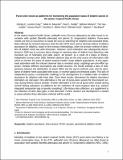Purse-seine vessels as platforms for monitoring the population status of dolphin species in the eastern tropical Pacific Ocean : the use of fishing vessels as scientific platforms
Abstract
In the eastern tropical Pacific Ocean, yellowfin tuna (Thunnus albacares) are often found in association with spotted (Stenella attenuata) and spinner (Stenella longirostris) dolphins. Purse-seine vessels use this co-occurrence to locate the tuna by searching for dolphins and associated birds. Data collected by onboard observers since the late 1970s were used to develop indices of relative abundance for dolphins, based on line-transect methodology, when the primary method of detection of dolphin herds was with binoculars. However, trend estimation was subsequently discontinued in 2000 due to concerns about changes in reporting rates of dolphin herd detections with increased use of helicopter and radar search. At present, as a result of a hiatus in fishery-independent surveys since 2006, fisheries observer data are the only source of information with which to monitor the status of eastern tropical Pacific Ocean dolphin populations. In this paper, trend estimation with the onboard observer data is revisited using a sightings-per-unit-effort approach. Despite different assumptions and model structure, the results indicate a lack of independence between the distribution of search effort and the search methods used, and the abundance of dolphin herds associated with tunas, on several spatial and temporal scales. This lack of independence poses a considerable challenge to the development of a reliable index of relative abundance for dolphins with these data. Given these results, alternatives for dolphin abundance estimation are discussed. One alternative is the use of purse-seine vessels for line-transect surveys during fishery closure periods. Another alternative is the use of purse-seine vessels during normal fishing operations as platforms for the collection of mark-recapture data (e.g., passive integrated transponder tags or genetics sampling). Life-history data collection, as a supplement to the collection of other data types, is also discussed. Further research and development is needed to assess whether these alternative methods will be useful.
Citation
Lennert-Cody , C E , Maunder , M N , Fiedler , P C , Minami , M , Gerrodette , T , Rusin , J , Minte-Vera , C V , Scott , M & Buckland , S T 2016 , ' Purse-seine vessels as platforms for monitoring the population status of dolphin species in the eastern tropical Pacific Ocean : the use of fishing vessels as scientific platforms ' , Fisheries Research , vol. 178 , pp. 101-113 . https://doi.org/10.1016/j.fishres.2015.10.005
Publication
Fisheries Research
Status
Peer reviewed
ISSN
0165-7836Type
Journal article
Collections
Items in the St Andrews Research Repository are protected by copyright, with all rights reserved, unless otherwise indicated.

